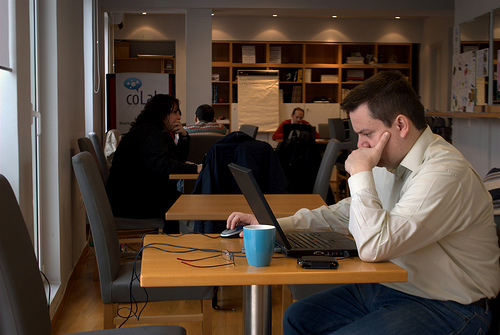You need their talent. Just not the office space.
How many of your employees really need to be in the office?
Answer: A lot fewer than you might think.
Thanks to technology & our connected world, millions of jobs currently worked in an office, don’t need to go in. I argue (and I’m not alone in this) that half of your office personnel does not need to be in said office, to do their job.
Which half? Ah, that’s the question. My answer is: Those who are not location-based.
What’s that mean? Essentially, it means those employees whose labor is defined by output, not by physical presence.
Here’s an example. In the Ford assembly plant back in the day, you had hundreds of line workers. Each attached a part, turned a bolt, and so on. By this division of labor, Henry Ford built the Ford Motor Company into a titan.
Now, an assembly line worker must be physically present. They cannot attach a part from home. But what about a Marketing specialist?
Their work deals in leads, content, emails, and conversations. The output is almost totally on the Web. Thus their physical presence is not necessary. They can do the job anywhere.

(This is a short example. I’ll expand on the notion in future posts.)
So the question now becomes, Which employees don’t need to be in the office, to do their work?
Let’s take four examples: HR Manager, Operations Manager, Website Developer, and Marketer.
Overall, none of these people actually need to work from within an office.
I’ll go through their roles, and illustrate why.
Four Roles Defined By Their Output
Let’s examine these four office roles. What do they do?
HR: Recruits for positions. Planning staff development. Handles office policies.
Manager: Keeps track of employees. Produces reports. Oversight on materials or processes.
Website Dev: Maintains website. Creates tools and patches. Secures the backend.
Marketer: Works on marketing campaigns. Coordinates with Sales. Creates & publishes content online.
A bit oversimplified, but you understand where I’m coming from here. Each employee in these roles has certain tasks to accomplish. The thing is, these tasks are all defined by one thing: OUTPUT.
The results of the role’s work are in some form of output. Not a physical effect, but an operational result. Let me illustrate the type of output each role generates.
- HR – Reliable employees
- Manager – Improved operations numbers & satisfied employees
- Website Developer – Optimized websites and tools for customer use
- Marketer – Qualified leads going to Sales
Do they need to be in the office to produce these types of output?
No. So long as they have computers and a phone, none of them require it. They only come to the office because of the old “corporate standard.” That standard is rapidly dying…and it should. We are in the beginning of a new age of work.
If they’re not in the office though, how do you know they’re working? You will if they go to a place which maximizes their output.
What’s the Best Location for Maximum Output?
Since their roles are defined by output, these employees should be in a location where that output is maximized. Optimal environment for productivity, right?
Where would they go other than the office, to do their work? Most would say ‘Stay Home,’ and that is by & large the best option. However, others do exist. They could move between home and a coffee shop. Go to a co-working space. Even station themselves at a customer site.
Where SHOULD they go to work? Depends on the person, and the role they fill. I used to think ‘Home’ was always the first answer. But after giving it more thought, I would say a better answer is…
Employees should work from the place best suited to their productivity, depending on the person & the role.

A co-working space…great for maximizing output! Photo by karpidis 
Let’s go through the four locations I mentioned already. Each has advantages & disadvantages to remote employees, depending on the role.
- Home: All (but especially Manager & HR). Why? Potential for dealing with company IP (Intellectual Property). You don’t want to download and read through confidential data in a coffee shop.
- Coffee Shop: Developer, Marketer. While some of their data is confidential, it’s not as mission-critical as material controlled by Management & HR. Use of a VPN will secure the developer’s backend data, and the Marketer’s leads.
- Co-Working Space: HR, Developer, Marketer. These employ security and office-grade services. A useful tool when needed, and they provide an office-like environment if desired.
(I don’t include Manager here because I’ve read stories of Managers in a co-working space, who felt the need to ‘manage’ the people around them!) - Customer Site: Developer, Manager (if acting as a consultant or advisor). I’ve worked with developers who chose to work at a customer site, while they worked on that customer’s project. It allowed them immediate access to their customer contacts on time-critical projects. The important thing to remember is, they were not assigned to the customer site. They chose to go there because they knew it would maximize their productivity for the project.
Finding Out the Best Location: Conduct Trials
How do you find out the best way to maximize your employees’ output? Look to the developer example I just gave. He ordinarily worked between an office and his house. But in the short-term, going to the customer site allowed him to shorten the project time by one full week.
Employees usually know what they need to do their best work. To find this out, conduct trials with your employees. Have them work from home for 1 week. Encourage them to try out a co-working space for 2.
You can run the trials by department, by role, or both. That depends on your feelings & those of your employees. Once the trials are done, have each employee report back on where they think they’re most productive.
Important: Do not share these reports with others. If you give employees the option to work remotely, but share around their reasons for doing so? You could end up embarrassing some employees, which can lead to irritation and possibly losing them.
Remote Work Effects: Productivity Boosts
What effect would moving employees like the Head of HR or Lead Marketer outside the office have? Well, consider where they are now, and what the move was meant to do. A remote employee has now chosen a location where they feel they’re the most productive.
The natural result? A productivity boost.
Since they are where they’re most productive, you’ll see improvements in their day-to-day productivity above their prior output. Not only that, but over the long term, both they and the business see gains. More efficient use of time (e.g. no more commute), lower operational expenses (office power, materials not used as much), and higher customer satisfaction (productive employees feel happier overall, which carries over into their customer-facing activities).
This multiplies across each remote employee. Think of half your office, doing their best work in an environment maximizing their output. Your bills go down by a huge number (I recall a case study where one office saved 30% on expenses via remote work). Your output gets a boost. Your customers are happier.
You still need their talent…just not their presence.
